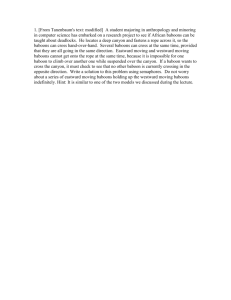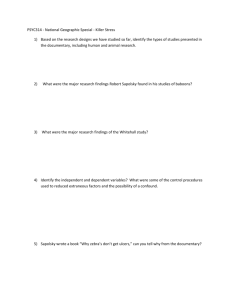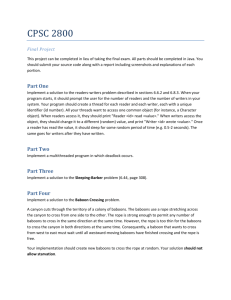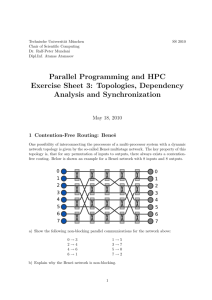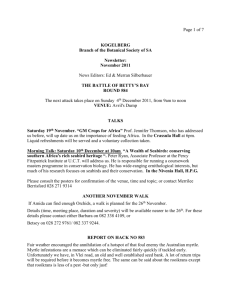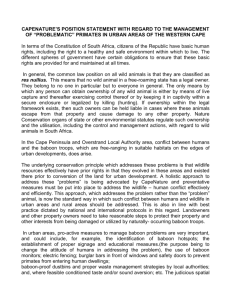Document 10527596
advertisement
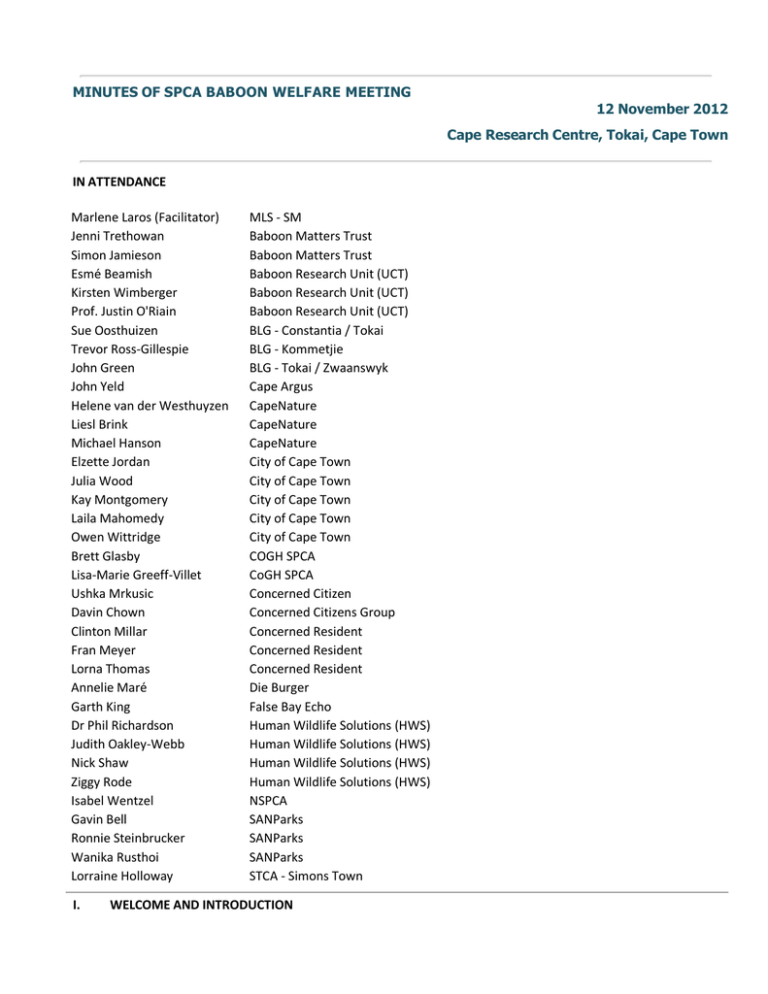
MINUTES OF SPCA BABOON WELFARE MEETING 12 November 2012 Cape Research Centre, Tokai, Cape Town IN ATTENDANCE Marlene Laros (Facilitator) Jenni Trethowan Simon Jamieson Esmé Beamish Kirsten Wimberger Prof. Justin O'Riain Sue Oosthuizen Trevor Ross-Gillespie John Green John Yeld Helene van der Westhuyzen Liesl Brink Michael Hanson Elzette Jordan Julia Wood Kay Montgomery Laila Mahomedy Owen Wittridge Brett Glasby Lisa-Marie Greeff-Villet Ushka Mrkusic Davin Chown Clinton Millar Fran Meyer Lorna Thomas Annelie Maré Garth King Dr Phil Richardson Judith Oakley-Webb Nick Shaw Ziggy Rode Isabel Wentzel Gavin Bell Ronnie Steinbrucker Wanika Rusthoi Lorraine Holloway I. MLS - SM Baboon Matters Trust Baboon Matters Trust Baboon Research Unit (UCT) Baboon Research Unit (UCT) Baboon Research Unit (UCT) BLG - Constantia / Tokai BLG - Kommetjie BLG - Tokai / Zwaanswyk Cape Argus CapeNature CapeNature CapeNature City of Cape Town City of Cape Town City of Cape Town City of Cape Town City of Cape Town COGH SPCA CoGH SPCA Concerned Citizen Concerned Citizens Group Concerned Resident Concerned Resident Concerned Resident Die Burger False Bay Echo Human Wildlife Solutions (HWS) Human Wildlife Solutions (HWS) Human Wildlife Solutions (HWS) Human Wildlife Solutions (HWS) NSPCA SANParks SANParks SANParks STCA - Simons Town WELCOME AND INTRODUCTION Minutes: SPCA Baboon Welfare Meeting 12 November 2012 Isabel Wentzel (IW) opened the meeting, welcomed the attendees and introduced the facilitator, Marlene Laros (ML), who confirmed the agenda for the meeting and covered the house rules. 2. PRESENTATIONS AND QUESTIONS i. BABOON POPULATION - Esme Beamish (Baboon Research Unit – UCT) Esme Beamish (EB) presented data on the baboon population in the Western Cape and summarised the current status of the baboon troops, population growth, human-induced injury and mortality statistics, euthanasia statistics and the background to and behaviour of splinter troops. EB confirmed that the growth of the baboon population was consistent and strong and the overall number of baboon mortalities was down in 2012 when comparing 2010 - 2012 data with 2006 - 2008 data. Furthermore EB confirmed that human-induced retributive baboon mortalities had reduced in markedly in the same period. The following issues arose: Baboon population data is available in academic theses conducted by the University of Cape Town. Summary data has been presented at 28 public meetings during the past two years. A population census is being currently undertaken. Baboon Matters Trust questioned the reliability of the data presented. The chairperson asserted that the data from the University of Cape Town was scientific and was to be viewed with the trust and integrity it deserved. ii. SERVICE PROVIDER REPORT - Dr Phil Richardson (Human Wildlife Solutions – HWS) Phil Richardson (PR) presented information regarding baboon management for the period August 2012 to date covering the hotline call data, percentage of time the baboon troops spent out of the urban area in relation to the requirements of the contract with the City of Cape Town, public education, staff training, recruitment criteria and methodology. PR confirmed that HWS employs managers and supervisors that are qualified in conservation, zoology or other relevant areas of study as baboon management is a professional occupation hence the employment of professional people in the organisation. PR discussed the use and the success of using paintball markers in the management of the troops, and covered the extensive training that HWS staff undergoes in the use of various techniques and equipment. PR advised the meeting of new technology that is being used including remote radio telemetry and closed off by giving an overview of the positive feedback that is being received from the residents of Cape Town. PR reflected on the previous questions raised regarding data and stated that HWS will keep a running total of the data collected and will update this information via the monthly report. The following issues arose: The approval of the use of paintball markers by the NSPCA and SPCA was questioned and the Protocol and SOP was clarified. Tracking of the efficacy of the methods used was explained and clarified. Harassment by members of the public was discussed at length and parameters clarified. It was Page 2 Minutes: SPCA Baboon Welfare Meeting 12 November 2012 agreed that threatening behaviour towards others is against the law and as such the protection of the law could be called on. iii. PRINCIPLES OF THE 2013 ROADMAP - Gavin Bell (SANParks) Gavin Bell (GB) advised the meeting that the three authorities had reached consensus and the vision going forward would be aimed at maintaining a sustainable population of baboons on the Cape Peninsula, and that baboons must be kept out of the urban areas in order to reduce human / baboon interaction and conflict. GB advised that there would be a roadmap which would involve public engagement in the areas on the Cape Peninsula. The following issues arose: It was clarified that the public participation process would take place during the course of 2013 commencing in February, and continuing for approximately three to six months to conclusion. The question of desirability of an electric fence in the Scarborough and Kommetjie areas was raised and would be covered during the public participation process. Euthanasia was discussed and the SOP was clarified. It was agreed that all parties need to work together towards a solution. iv. BABOON MATTERS TRUST - Simon Jamieson (BMT) Simon Jamieson (SJ) called for positivity going forward and posed a number of issues and questions to the meeting as follows: At the outset SJ clarified that the BMT position statement is that they do support euthanasia but not under all circumstances hence they would like clarity on the circumstances where euthanasia would be used, and assurance that the protocol was being adhered to. SJ stated that the BMT does accept the use of averse conditioning methods under certain circumstances but would like to have access to data that proves its efficacy. SJ confirmed that the BMT supports the Protocol which is also stated on the BMT website. The question of enforcement of by-laws and education of the public was raised and SJ stated that the BMT would like to see management of the entire situation, in other words, baboon management needs to be used in conjunction with other things like public education in order to solve the issue. SJ added that the BMT is involved in education projects. SJ raised the issue of what to do regarding splinter troops and advised that, if relocation was considered, the BMT would be happy to look at the funding and undertaking the relocation of the animals. SJ further advised the meeting that the BMT would like to have a sanctuary for injured baboons and could raise funds for this purpose. The following issues arose: Regarding public education, it was clarified that the Baboon Liaison Group (BLG) comprises numerous volunteers and are involved in public education such as the current project that is taking place on the weekends where baboon management and other issues are covered at a Page 3 Minutes: SPCA Baboon Welfare Meeting 12 November 2012 v. public venue in the area concerned. Public education undertaken by the City of Cape Town (CoCT) was also discussed and covered. The reasons for the formation of splinter troops was explained as well as the reason for their tendency to raid. The difference between a fission and a splinter troop was also clarified. The question regarding trust and acceptance of verified scientific data was highlighted, as well as the interpretation of data. It was confirmed that the HWS Monthly Reports are available to the public via the CoCT and CapeNature websites, and would be available via the HWS website as soon as it goes live. The CoCT’s biodiversity strategy, and the importance of baboon management within that strategy, was covered and it was agreed that it is not healthy for baboons to be in human areas. PUBLIC EDUCATION, WASTE MANAGEMENT AND COMMUNICATION – City of Cape Town – Dr Elzette Jordan (EJ) Elzette Jordan (EJ) covered the CoCT’s role and investment in public education regarding baboon and waste management which impacts on the incidence of baboon activity. Amongst the various tools used are pamphlets, posters, banners, visitor leaflets and public participation. Meetings are also held with stakeholders such as the tourism industry and presentations are made to tour guides. The CoCT also implement outreaches at shopping malls, libraries, open days, tourism expos, mail drops and releases in the media. Examples cited were an outreach arranged with ACSA and the upcoming Open Day at Welcome Glen. With regard to waste management, development included the production of double-lockable bins. Furthermore discussions around waste management issues have and are taking place with businesses in the area, through property audits, and through the involvement of the Navy in respect of their property. EJ stated that the CoCT’s motive was to improve the welfare of baboons and people through these interventions. EJ thanked the BLG and their volunteers for the extensive assistance in this regard. The following issues arose: The CoCT’s budget for Baboon management and education was discussed and clarified. In respect of translocation of baboons, the risk of spreading pathogens and diseases such as Hepatitis was discussed including the risk to human health. The importance of cultivating a culture of waste management was agreed and it was suggested that independent bodies such as Plastics S A are approached to investigate harbour and other clean-ups in the area vi. LAW ENFORCEMENT – CapeNature – Helene van der Westhuizen (HvdW) Helene van der Westhuizen (HvdW) presented and reviewed the legal aspects regarding baboon management on the Cape Peninsula and explained the applicable legislation, by-laws and permits required. HvdW clarified that the overall role of CapeNature is to enforce legislation, protect wild animals and enforce the fact that feeding baboons is illegal. With regard to waste management, HvdW suggested that by-laws in respect of waste management (enforcement of the use of baboon proof bins in baboon areas), garden waste management (compost heaps) and recycling should be considered. HvdW advised the meeting that CapeNature conduct baboon patrols, provide training to the service Page 4 Minutes: SPCA Baboon Welfare Meeting 12 November 2012 provider’s rangers in respect of basic law enforcement through the HNCO (Honorary Nature Conservation Officer) qualification, are involved in educational projects and issue media releases regarding awareness. The following issues arose: The need for solid evidence was emphasised in respect of individuals who are breaking the law. vii. BABOONS AND WELFARE ISSUES – NSPCA – Isabel Wentzel Isabel Wentzel (IW) discussed the issue regarding the fact that due to various factors, the baboons have lost their fear of humans and associate humans with food which results in conflict, which results in baboons being hurt or killed. Furthermore, it is too late to rectify the displacement of baboons hence the need for baboon management. IW raised the points that (i) the problem is not going to go away, (ii) humans need to manage baboons and failure to do so will not help the baboons, and (iii) the NSPCA and SPCA are there to stop people from taking the law into their own hands. IW stated the importance of managing baboons and ensuring that they re-learn fear of humans, and that baboons experience an increase in cost to themselves regarding seeking food in urban areas. IW explained that deterrents are not used to cause harm but are used to prevent cruelty to baboons and it is vital that baboons are kept away from people and persuaded to be wild baboons again. Welfare issues also arise where baboons are in close contact with humans such as genetic weaknesses, sickness such as TB from humans, and human-inflicted injury to the baboons. The following issues arose: A discussion arose around sanctuaries. IW confirmed that there are two sanctuaries for baboons in South Africa, one where no more baboons can be accommodated and the other, in Phalaborwa, houses between 600 and 700 baboons in cages. Problems faced include difficulties in procuring funding, restrictions regarding areas where the baboons can be released, genetic problems, problems that arise from the animal’s boredom, and the perpetuation of splinter troop behaviour. viii. THE WAY FORWARD: CLOSING STATEMENTS – NSPCA – Isabel Wentzel Isabel Wentzel (IW) emphasised that, for the benefit of the baboons, it is vital for baboons to be baboons and not live with humans and she asked for commitment from both sides in the management of baboons. IW stated that the BTT has a difficult task in managing both baboons and people and she stressed the importance of the role of the service provider in managing baboons on the Cape Peninsula. ix. SUMMARY AND CLOSURE OF MEETING – Marlene Laros (Facilitator) Marlene Laros (ML) closed the meeting and summarised the points agreed upon: Page 5 Baboon population data would be made available in mid-January 2013. Efficacy of baboon management strategies would be monitored. Issues regarding public information and education would be given attention. Guidelines on how to obtain the correct information in order to secure prosecution for unlawful Minutes: SPCA Baboon Welfare Meeting 12 November 2012 behaviour would be clarified. ML commented that although this had not been an easy meeting, all seemed to be aligned with what was needed and that it would be beneficial if efforts were aligned. Page 6
